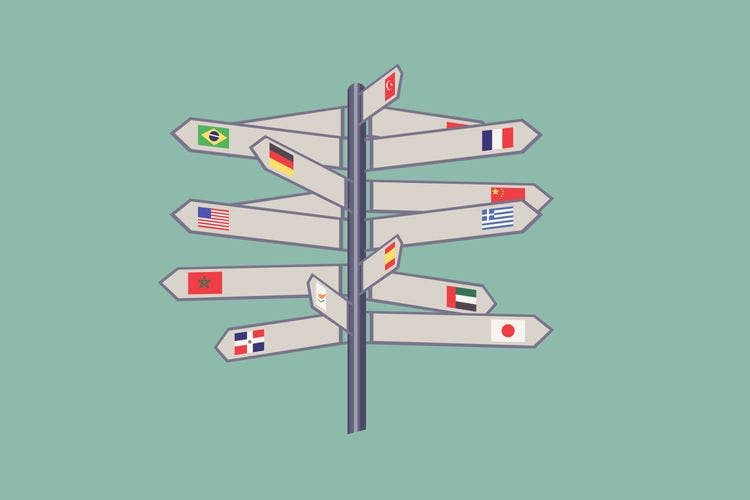Beyond Borders: A Tour of Spanish-Speaking Countries

Contents
Spanish is spoken by millions of people. Knowing it opens many doors, as 21 countries have it as their official language. Just like English, it is used all over the world. From Argentina to Spain and Mexico to Chile, being able to speak in this tongue means you can connect with people across several continents. So, whether you want to chat with locals on your next trip or expand your professional network, learning Spanish is a good decision. Below is a complete list of Spanish-speaking countries.
A Brief History of the Spanish Language
The history of Spanish begins with Latin. When the Romans came to the Iberian Peninsula around 200 BCE, they brought this tongue. It changed and mixed with local dialects. Over time, this blend became what we call Vulgar Latin today.
By the 8th century, Arabic influences came into play due to Muslim rule over parts of Spain. Many Arabic words were entered into Spanish at that time. Then came the Reconquista, a series of campaigns by Christian states to reclaim territory from Muslims. This period strengthened and unified local dialects into what we now know as Old Spanish.
Colonialism spread Spanish far beyond Europe starting in the late 15th century. Explorers and settlers carried it to the Americas, Africa, and Asia. In these new lands, indigenous languages influenced local dialects of Spanish as well.
Like English, Chinese, and Hindi, Spanish is one of the most spoken languages in the world today. It grew not only in Spain but in many parts of the world, and currently, there are 21 countries that speak Spanish officially. Various nations have their own accents, but they all share the same base and words. Speakers from different areas can still understand one another.
How Many People Speak Spanish?
Around 483 million people speak Spanish as their native language. This makes it the second most spoken native tongue in the world, after Chinese. Spanish surpasses English in this regard.
When we include those who use the tongue as a second language, the number rises to about 591 million people worldwide. It places Spanish as the third most spoken language globally, behind Chinese and English, and on par with Hindi.
Over 60 million people identify as Hispanic in the United States alone. By 2021, around 11% of Americans used Spanish as their primary language. The tongue also ranks high among languages used on the internet, and there are many active communities across social networks.
What Countries Speak Spanish Around The World
Spanish is not limited to one region. Different nations use it as their primary tongue across continents, from Europe and the Americas to parts of Africa. Some have millions of native speakers, while others have smaller populations who speak it fluently. Below, we will look at what are Spanish-speaking countries.
Africa
Spanish in Africa might surprise some, but it is indeed there. Equatorial Guinea is the only African country where Spanish is official. With around 1.7 million people, about 90% speak it here. The language came with colonial rule and stayed key in daily life.
| Country | Capital | Population | Distribution |
| Equatorial Guinea | Malabo | 1,752,867 | 90% |
South America
Spanish is the main language in South America. It links the region and lets cultures share stories and ideas across borders. Each country has its own sound and special words.
In Argentina and Chile, the tongue has a unique beat and tone. Argentinians often say vos instead of tú for the informal “you”. In Peru and Bolivia, native tongues like Quechua and Aymara still exist next to Spanish.
Cities like Bogotá in Colombia or Buenos Aires in Argentina often set trends in new words or phrases that spread across all Spanish-speaking countries in South America. Yet, in rural places, Spanish often takes on a more traditional form.
| Country | Capital | Population | Distribution |
| Colombia | Bogota | 52,327,414 | 86.8% |
| Argentina | Buenos Aires | 46,043,015 | 96.2% |
| Peru | Lima | 34,666,120 | 82.5% |
| Venezuela | Caracas | 29,366,035 | 81% |
| Chile | Santiago de Chile | 19,657,313 | 95.2% |
| Ecuador | Quito | 18,367,575 | 85% |
| Bolivia | Sucre and La Paz | 12,557,951 | 60.2% |
| Paraguay | Asunción | 6,942,773 | 68% |
| Uruguay | Montevideo | 3,423,305 | 98.8% |
Central America
In Central America, Spanish is the main language. The list of Spanish-speaking countries includes Guatemala, Honduras, Nicaragua, El Salvador, Costa Rica, and Panama. Most people here speak it well.
The strong influence of Spanish comes from the colonial era when Spain ruled this area. Over time, the language changed a bit but kept much of its form. Still, each country has some unique ways of speaking.
For instance, Guatemalans speak more formally than people from other countries in the area. On the other hand, Nicaraguans often make words or phrases shorter when they talk casually. Also worth noting is that many communities still use native language. It creates an environment where both languages live side by side.
| Country | Capital | Population | Distribution |
| Guatemala | Guatemala | 18,344,445 | 69% |
| Honduras | Tegucigalpa | 10,750,709 | 93% |
| Nicaragua | Managua | 7,137,481 | 90% |
| El Salvador | San Salvador | 6,394,651 | 93% |
| Costa Rica | San Jose | 5,244,908 | 88% |
| Panama | Panama City | 4,524,820 | 77% |
1
North America
In North America, Mexico is the biggest country where people speak Spanish. Mexico City, the capital, is a key place for the language. With around 129 million people, about 98.5% speak it fluently.
Spanish in Mexico has some special words you don’t hear in other places. They show up a lot in TV shows, songs, and poems across the country. Influences from native languages add to these unique features. Even with different accents and words in each region, everyone in Mexico can still talk to each other easily. This shared language helps people connect all over the country.
| Country | Capital | Population | Distribution |
| Mexico | Mexico City | 129,339,672 | 98.5% |
Caribbean
The Caribbean has several Spanish-speaking countries. Cuba, the biggest island in the area, uses Spanish as its main language. The Cuban way of speaking is special with different sounds and words. For example, many Cubans do not pronounce the last “s” in words.
Puerto Rico, a U.S. territory, also speaks Spanish and English. Puerto Rican lingo is similar to other Caribbean types but has words from English because of its link to the U.S.
The Dominican Republic also uses Spanish as the primary language. Here, their way of speaking mixes African and native elements with the standard tongue. People speak fast and often shorten words in daily talk there.
| Country | Capital | Population | Distribution |
| Cuba | Havana | 11,175,621 | 94% |
| Dominican Republic | Santo Domingo | 11,428,717 | 90% |
| Puerto Rico | San Juan | 3,268,359 | 84% |
Europe
Spain is the main country that speaks Spanish in Europe. The nation has a rich history, from medieval times to modern-day culture. Madrid, the capital, is a hub of economic and political events.
The Royal Spanish Academy, based in Spain, controls the language for all Spanish-speaking countries. This institution sets grammar rules and oversees updates on new words and usages.
| Country | Capital | Population | Distribution |
| Spain | Madrid | 47,475,783 | 92% |
Other Countries that Speak Spanish
The language spreads its influence beyond official borders. In the United States, over 35 million people are native Spanish speakers. Cities like Los Angeles and Miami have large Hispanic communities.
Canada also has many people who speak Spanish, especially in cities like Toronto and Vancouver. In Europe, France has its share, too. In the southern parts of France, close to Spain, many people use it fluently.
| Country | Continent | Capital | Spanish speakers | Distribution |
| United States of America | North America | Washington, DC | 35,662,000 | 10.7% |
| Canada | North America | Ottawa | 506,000 | 1.3% |
| France | Europe | Paris | 272,000 | 0.4% |
| Belize | Central America | Belmopan | 186,000 | 46% |
| Switzerland | Europe | Bern | 97,000 | 1.1% |
| Sweden | Europe | Stockholm | 63,000 | 0.6% |
| Andorra | Caribbean | Andorra la Vella | 36,000 | 44.6% |
| Virgin Islands | Caribbean | Charlotte Amalie | 18,000 | 16.8% |
| Aruba | Caribbean | Oranjestad | 15,000 | 13.7% |
| Curaçao | Caribbean | Willemstad | 6,000 | 4% |
Interesting Facts about Spanish Countries
Spanish-speaking countries have rich culture and history. Each nation has its own traditions, dialects, and well-known places. These things shape their identities and link them through a common language. Here are some points that show the variety in all Spanish countries:
- Mexico’s Day of the Dead. This country celebrates Día de los Muertos, where families honor deceased loved ones with altars and offerings.
- Argentina’s tango. Often associated with Argentina, tango dance originated in Buenos Aires in the late 19th century.
- Spain’s Sagrada Família. An iconic basilica designed by Antoni Gaudí in Barcelona is a key example of modernist architecture.
- Chile’s astronomical observatories. The Atacama Desert offers some of the clearest skies for stargazing and houses many observatories.
- Peru’s Machu Picchu. A UNESCO World Heritage Site, this ancient Inca city is one of the New Seven Wonders of the World.
- Costa Rica’s biodiversity. Despite its small size, this Spanish-speaking country hosts about 5% of the planet’s biodiversity, with numerous national parks and reserves.
- Colombian coffee. Colombia is known globally for its high-quality coffee beans, grown in the Coffee Triangle region.
- Cuba’s classic cars. In Havana, visitors can see many vintage American cars from the 1950s, a result of historical trade restrictions.
- Bolivia’s Salar de Uyuni. This vast salt flat is the largest in the world and creates stunning reflective landscapes after rainfall.
These examples show the unique cultural and natural treasures in places that speak Spanish. Each place offers something special, from ancient ruins to bright festivals and stunning landscapes.
Promova: Learn Languages at Your Own Pace
Promova makes it easier to learn Spanish, English, French, Chinese, and other languages. We offer courses for different skill levels. You can start from scratch or improve existing knowledge.
Our app for Android and iOS allows you to study any time you have a few free moments. Each lesson is concise, so busy people can fit language learning into their day. Courses focus on elements like new words, phrases used by locals, and grammar explanations. You can also find tests that help you practice with real-life examples.
We also help people learn English with one-on-one lessons. In these sessions, we focus on your specific needs. If you have trouble with pronunciation or require help with hard grammar points, our tutors provide targeted feedback.
Conclusion
Spanish links millions of people across many continents. With 21 Spanish-speaking countries officially using it, the language brings cultures, histories, and traditions together. It helps people chat in Europe, the Americas, and parts of Africa. If you want to learn Spanish and seek new opportunities, you will find it helpful in many parts of life. From simple talks to work settings, it opens paths to rich experiences.
FAQ
How long does it take to become fluent in Spanish?
Fluency varies depending on study habits and exposure. With consistent practice and immersion, one might achieve this level in 600-750 hours of study. It includes regular speaking, listening, and grasping grammar elements like verb conjugation and sentence structure.
What are some tips to improve Spanish pronunciation?
Listen to native speakers through podcasts or videos. Practice speaking out loud regularly, focusing on difficult sounds. Record your voice and compare it to native speakers as well.
Are there different dialects of Spanish?
Yes, regional dialects vary in pronunciation, vocabulary, and grammar. Major ones include Castilian (Spain), Latin American (Mexico), Rioplatense (Argentina/Uruguay), Caribbean, Andean, and Chilean Spanish.
What resources can help me learn Spanish?
BBC Languages provides audio and video lessons, as well as interactive exercises. WordReference is also useful for looking up definitions and translations.



Comments